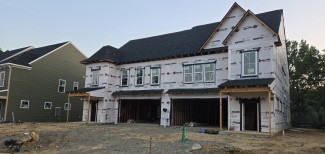Building energy codes play a crucial role in reducing energy costs for families and businesses. However, to achieve those results, states and cities need to invest in a series of steps to ensure that these policies are implemented effectively.
Building energy codes establish the minimum energy efficiency level for new homes, apartment buildings, and commercial properties. With rising demand for electricity putting increasing strain on the grid, the Pacific Northwest National Laboratory found that fully implementing adopted model codes would save 16.75 quads of energy over the next 15 years, enough to power about 220 million homes. When implemented effectively, these standards achieve significant cost and energy savings while supporting safe, healthy, and affordable environments in which to live, work, and learn.
However, these benefits can only be realized if the energy codes adopted by states or municipalities are enforced and complied with, ensuring that what’s on paper translates to real-world results. Effective implementation requires a well-resourced workforce, access to technical assistance, coordinated policy, and an engaged community.
Efforts to improve energy codes focus primarily on adopting model codes. When jurisdictions adopt new codes, from the latest model codes to stretch codes that go beyond the model, unlocking the full impact of these policies depends on implementing them effectively. Multiple energy code field studies have shown compliance gaps after codes have been adopted, indicating that the benefits are not fully realized.
In some jurisdictions, adopting a new or stronger code may not be possible due to timing, a lack of authority to adopt, or political opposition that weakens any new code through amendments. In such cases, it’s even more critical to maximize the impact of whatever code is in place. Effective implementation and compliance efforts can help realize energy and cost savings even without an updated code. Regardless of a jurisdiction's stage in its adoption journey, enforcing and supporting the current code will move the needle in building energy efficiency.
What does effective implementation look like? Though specific states and localities will always have unique needs, certain activities that support effective energy code implementation should be embraced by jurisdictions:
- Adequate resources, skills, and systems (capacity building) in state and local agencies for building permit and plan review, site inspections, and other code compliance activities promote stronger code enforcement. Building departments also require updated systems and technologies that support building officials, such as digital permitting and plan review software, as well as virtual inspection tools
—Bryce Puck, Nebraska Department of Environment and Energy
—Heather Cowley, Pennsylvania Department of Environmental Protection
—Mary English, Metropolitan Energy Center
—Leslie Ethen, Southwest Building Code Collaborative
- Workforce development for new members of the energy-efficient construction workforce: Training, education, and ongoing development are critical to code implementation. As outlined in our 2025 topic brief, effective implementation depends on a workforce with up-to-date technical skills, a clear understanding of available career pathways, and a deep appreciation for how energy codes impact the communities they serve.
- Code official engagement and training: Training for local and state officials ensures they stay current with the latest codes. Well-trained officials are better equipped to identify when buildings fall short of requirements and to support industry efforts to close compliance gaps. Many organizations offer free resources and training, which can be accessed through the Building Energy Codes Resource Hub.
- Training and technical assistance for key stakeholders: Effective implementation also depends on builders, developers, architects, and engineers understanding the codes and how to apply them in their projects. States and localities can strengthen compliance by providing targeted training and resources that support these stakeholders.
- Policy and agency coordination across energy efficiency policies: Aligning energy codes with other policies that impact energy efficiency—such as building performance standards and retrofit programs—improves resource
- efficiency, streamlines training and compliance, and can reduce confusion for stakeholders navigating multiple sets of requirements. A recent ACEEE brief details how consistent metrics and processes between building performance standards and energy codes can minimize redundancy, improve clarity for stakeholders, and drive performance improvements.
- Community engagement: While engaging businesses, residents, and other community members may not be the top priority of every code department, creating access to information for stakeholders can increase accountability. This can encourage broader participation in future code adoption processes, ensuring that adopted policies better reflect local needs and priorities.
—Clayton Trevillyan, Southwest Building Code Collaborative
Not all jurisdictions face the same challenges in implementation. Still, as Adam Berry of the Colorado Energy Office reminds us, we “don’t need to reinvent the wheel, and solutions that will work in one community will work in another.” While specific needs may vary, striving for consistency in how jurisdictions approach common challenges “makes implementation easier and more equitable,” Berry said. To get started, jurisdictions can take stock of their current activities—identifying strengths, uncovering compliance gaps, and listening to stakeholder pain points. From there, they can adapt proven strategies to meet local needs. For example, if long travel times between site inspections are creating bottlenecks, a jurisdiction could evaluate virtual inspection tools to address this issue.
Energy codes are more than just regulatory checkboxes—they are tools to protect public welfare and drive better building performance. Even the most advanced codes can fall short when communities lack effective implementation strategies. States and localities can start building stronger implementation infrastructure now to improve outcomes regardless of which energy code is in place. This infrastructure should equip building departments with the capacity to enforce codes, ensure that builders and design professionals understand how to comply, and help communities understand why these policies are important.
Real impact doesn’t happen when a policy is passed—it happens when that policy is put into practice. By investing in training, addressing resource and staffing gaps, and strengthening alignment between agencies, industry, and communities, we can ensure that the policy on paper translates into healthier, more efficient buildings and a more sustainable future for all.
This blog post was produced as a part of the National Energy Codes Collaborative, with funding from the U.S. Department of Energy. The quotes are from the collaborative’s Technical Advisory Group member presentations.

